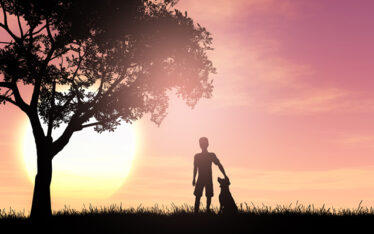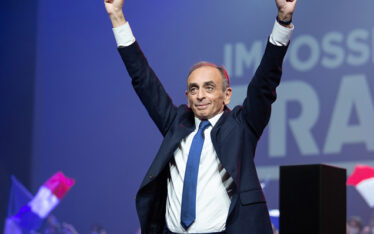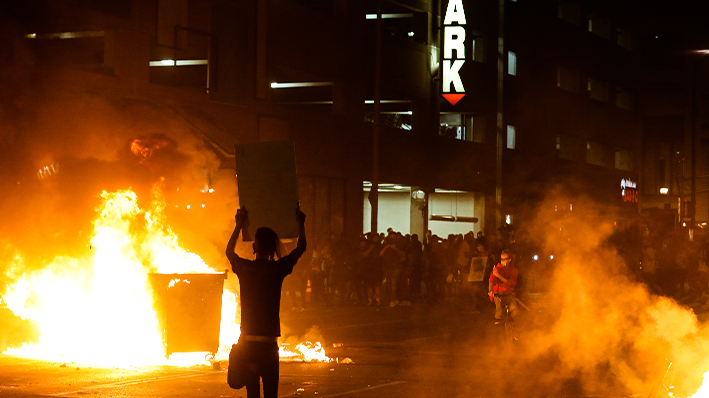
ChrisOwens/Shutterstock.com
Rioting is a dirty word. Rioters, as we are taught, are thugs, hoodlums and criminals. Never, does the mainstream glorify rioters as agents of change whose voices have been systematically removed and suppressed. However, such hasty judgement of rioters who agitate in the name of civil or human rights should not be dismissed so simply, rather we should reevaluate our perception of riots all together. It is time the riot is seen as a form of civil disobedience that does not reflect violent members, but rather the “voice of the unheard”.
Following George Floyd’s murder and the subsequent unrest, much of privileged America abhorred the site they saw in downtown Minneapolis. As the Minneapolis 3rd Police Precinct went up in flames, the local AutoZone was torched and a Target store looted, white America was incredibly quick to urge peace and calm as a means of change. While those on the Left urged peaceful protest and dialogue, the Right rushed to violence to battle\ the grieving, angry rioters and protestors. White politicians trotted out Martin Luther King’s name, many of whom likely for the first time. They urged peace in his name and for an end to the looting and violence. Alternatives to the violence were voting and peaceful gathering. However, these very suggestions fanned the flames in Minneapolis, New York, Seattle and cities around the world.
TIME FOR A CHANGE
After 400 years of harassment, abuse and even murder, the Black community in America has exhausted those avenues. In 2008 they voted for Barack Obama, a black man who stood for empowering the minority population in America. As for his success in taming the plague of police brutality, he found none. In 8 years of control, 2 of which with a unified government, President Obama oversaw no major successful prosecutions of killer cops nor did he reign in the currently hotly debated precedent of Qualified Immunity.
Compounded with the failure of voting as a means for any change, even with a Black president, comes the concerted effort on behalf of many politicians to curtail the right of minorities to vote. Almost 6 million Americans are barred from voting due to prior Felony convictions; a field in which Black people are drastically over-represented. With Voter ID laws, “Perfect Match” laws and tactics of voter intimidation, many within the affected community have become disillusioned with the democratic process as a means to change.
MOVING FORWARD
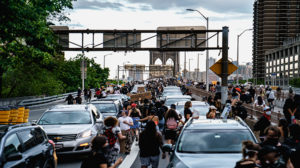
tetiana.photgrapher/Shutterstock.com
As for taking to the streets and marching? After centuries of largely peacefully organized protests against violence against black Americans, including those following infamous Birmingham Police Chief Bull Connor’s attack on peaceful protestors, there is nothing to show for it with regards to police brutality. Instances of reported brutality have skyrocketed one decade from the next as convictions for accused cops have become virtually non-existent.
On May 28th, rioters in Minneapolis spoke the language of their oppressor and sent shockwaves through the city, nation and the entire world culminating in possibly the largest civil rights movement in human history. The image of the police precinct in flames as protestors stood fast atop police vehicles and the burning building made its way into every publication in the Western World. An event we imagine only seeing in impoverished and warring countries came to our doorstep. Finally, after decades of voting, marching and demanding change, the burning precinct held the world captive to the issue of police brutality and became so omnipresent through the marches, riots and looting that those who previously would have continued on apathetically were unable to escape the topic.
YET ONCE AGAIN
Such was the case in 1992 following the police beating of Rodney King in LA and after the assassination of Martin Luther King Jr. Rodney King, a black man from Los Angeles, at the hands of police, there was massive violence in the streets that left several dead and hundreds of millions in property damages. By the time the riots had been quelled, LA had been shaken and scarred by the beating and the reaction. The LAPD commissioner Daryl Gates was immediately replaced by an elected civilian commission that oversaw the implementation of consent decrees. Activist and civil rights leader Susan Rice described the post-riots LAPD as “not your grandfather’s LAPD” among other praises for their reform.
The reasons for such reforms were numerous and the change was long awaited by many. However, without the riots that drew the attention of every Los Angeles resident and politician, it is unlikely such radical change would have occurred at the pace it did. In 1968, following one of the darkest days in American history as Dr. Martin Luther King Jr. was assassinated, mass riots broke out. Known as the King Assassination Riots or the Holy Week Uprising were the arguably the most destructive riots since the Civil War. Over 40 people were killed, there were billions of dollars in damages and tens of thousands arrested over the span of the riots. The damage and death, heavily concentrated in the initial few days drew the condemnation of white people, once again decrying violence as improper. Despite the palpable discomfort on behalf of White America, 6 days into the riots, President Lyndon B. Johnson signed the Equal Housing Bill. The Bill, one of the last major civil rights legislations of its time was rushed through as a means to calm the riots. Such a concession was driven to its speedy signing largely due to the anger and damage being caused by the riots.
A CRY FOR CHANGE
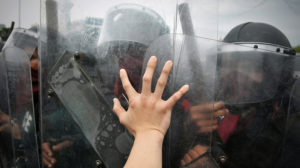
1000words/Shutterstock.com
Rioting has found major political success outside of domains of race. The famous Stonewall riots are almost unanimously considered the turning point in LGBTQ rights. The riot, started in New York City by a self-identified gender fluid individual who threw a brick at a police officer, set in motion a chain of events that would open America’s eyes to the unjust treatment of the LGBTQ community. When speaking of LGBTQ rights, it is impossible to not mention the root of change that was ignited with the Stonewall Riots.
The use of force through riots is no novelty in historical American society and politics. The Boston Massacre was prompted by a grouping of disorderly patriots throwing stones at British soldiers. Crispus Attucks, a black former slave, was killed that day and is recognized as the first casualty in the American Revolutionary War. The heroism of the rioting patriots is taught in schools. The Boston Massacre and the Boston Tea Party, instances of riots and looting, are foundational to the formation and maintenance of the American republic. The very right to protect oneself against a tyrannical government is deeply embedded in the Second Amendment.
PREVENTING OUTRAGE
In 2016, presidential candidate Hillary Clinton campaigned on gun reform. Never once mentioning a program of national hand-ins or confiscations. However, the narrative of “Gun-Grabbin’’ Democrats invaded the right wing’s rhetoric. Many who adopted such rhetoric were quick to remind Democrats that if they came for their weapons, they’d defend themselves. The explicit threat of violence against the government if they infringed on their Second Amendment right was seen as appalling for some. However, even as these calls for violence on the extreme ends of the right wing grew, White America’s discomfort remained limited. Some would argue that such a difference in perception was due to either the lack of credibility of the threat or rather that it was their race, almost entirely white, that prevented mass media outrage.
Fast forward to 2018 as thousands of individuals took to the streets in Philadelphia. For hours, cars were burned, stores razed to the ground and looted. The images that surfaced of this particular riot in February of 2018 are eerily similar to those out of Minneapolis. However, one riot was dominantly black while the other was a celebration “gone too far” following the Philadelphia Eagles Super Bowl Victory. Eight people in total were arrested and none critically injured by police. There are captured recordings of the Philadelphia Police Department frantically calling from support. Some transmissions even called for help from the National Guard and Homeland Security. Neither of these two departments were dispatched. The calm response on behalf of the government and the tame response of the media now speaks volumes as to how we perceive unrest in its peaceful and violent forms between White and Black Americans.
NOT A SPORT
Allow us to further consider the Eagles Super Bowl Riot. Eight people were arrested, 0 rubber bullets were shot, 0 counts of police brutality were reported, 0 tear gas canisters were shot, and no major official threatened to shoot looters on sight. Compared to the initial riot in Minneapolis, we see the clear disparity in treatment. There were hundreds of rioters and protestors arrested. There were dozens of tear gas canisters fired. Hundreds of rounds of rubber bullets not to mention many of which fired upon live-on-air reporters. There were over a hundred counts of alleged police brutality.
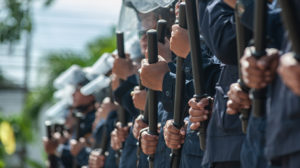
samsak.suwanput/shutterstock.com
One riot was incited by a win in a sporting championship that drew moderate attention but never widespread condemnation. Although businesses were looted and cars burned, the perception remained of an unfortunate event. As for in Minneapolis, the riot started as a reaction to the murder of an unarmed civilian, part of a long-running history of police murders of unarmed black people that some have dubbed ‘modern day lynching’. The difference between the immediate reaction in both cases rests squarely on the race of the agitators. When white gun-owners threatened open violent rebellion in response to proposed gun control legislation, there was a muted response without widespread discomfort, condemnation nor media attention. When fans looted stores and burned cars after the Super Bowl, few rioters were arrested, and they were simply allowed to riot without police opposition. When Black Americans rioted in response to a string of murders by police of unarmed Black men they were met with militarized police, widespread condemnation and violence with extreme prejudice. It must further be noted that this harsh, violent and aggressive approach to rioters was replicated against peaceful protests nationwide.
IN RETROSPECT
It is clear that we have lost touch with methods of effective civil disobedience and we have allowed for the development of a dangerous double standard based on race. America, politically and economically dominated by White America, has “white-washed” history as to omit instances of successful rioting in the name of civil rights. They have done so through the misinterpretation of Martin Luther King Jr.’s message, claiming inaccurately that he would want marches in the street as the form of change. Seldom do teachers teach of the MLK riots and their effect nor do they mention the radical changes found in the LAPD and NPD following the Rodney King Riots and the Newark Riots, respectively. The portrayal of civil rights has been domesticated by the mainstream in an effort to prevent discomfort. Such was clear as the sight of looters breaking into Target angered many White Americans far more than the sight of George Floyd gasping for breath as he was slowly murdered in plain sight.
While in the US we remember Dr. King as a peace-loving law-abiding man, we forget the very message of his famous “Letter from a Birmingham Jail” where he urges breaking the law as a means to stir discomfort and tension within the country. This ‘white-washing’ and domestication of sometimes violent civil rights movements is found internationally. Nelson Mandela is taught worldwide as a beacon of peace and love. He is heralded as a man who topped the most extreme segregation in the South African system of apartheid through peaceful organization. Forgotten, or much more likely, purposefully omitted, Mandela served as the leader of the militant wing of the South African Black liberation front. He was imprisoned not for protest as many would assume but rather terrorism charges. Through his leadership of the militant wing named Mkhonto We Sizw, he brought the Black South African struggle to the forefront of international attention. Although he emerged from prison with a message of peace, it was the bombings, riots and violence that shook the world and forced Americans and Soviets alike to turn their ire towards the South African government.
NEED TO REVIEW
Rioting as an effective means for change is an unfortunate reality in almost every political climate. If a movement is unable to hold the public hostage, then they can simply be ignored by the majority. When an athlete took a knee on national television, he quickly found himself unemployed and started a peaceful movement that would be attacked and rapidly dismissed. Conversely, the Minneapolis 3rd Police Precinct in flames on every TV, smartphone and tablet screen and printed across every newspaper headline made the newest iteration of Black Lives Matter inescapable. Today, cities nationwide are reviewing use of force policies, police budgets, police legal protections, minority community empowerment and for the first time in American history, beginning the nationwide conversation about institutional racism in its many forms. Companies from Target to the NFL have jumped out and committed hundreds of millions to the cause as well as internal reviews to promote equality. Derelict, violent and criminal officers are being held accountable more than ever before. In fact, the Minnesota District Attorney charged and executed a search warrant on disgraced Officer Derick Chauvin, who murdered George Floyd in a Minneapolis PD record time (4 days).
RESPONSIBILITY FIRST
Almost a month after the week of intense rioting, rioting as the “voice of the unheard”, as Dr. King once said, has transformed this country more than any civil rights march, lawsuit or media push. However, we have a responsibility not only to act in any capacity we can, but to also remember the events in Minneapolis and in cities nationwide. We must remember that when textbooks are written to reflect the successes of peaceful marches or ‘die-ins’, they are grossly incorrect and omit one of the most fierce, passionate and emotional events in American history. In this time, as students and members of society, we have a responsibility to fully educate ourselves and cast doubt onto the history books that profess a certain form of civil disobedience as the most effective. We must remember that the pacifying of urgent, impassioned movements is the tool of the oppressor to prevent a movement from threatening their status quo. Riots are as omnipresent in the history of change as peaceful protests and therefore should not be treated as a mere mob to be militarily crushed but rather to be listened to, given a platform and never again left unheard.
About the Article
A look at riots as a means of political expression demanding change.


